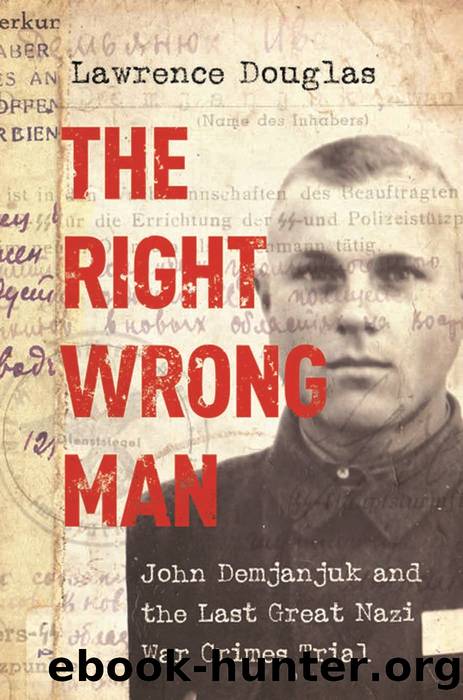The Right Wrong Man by Lawrence Douglas

Author:Lawrence Douglas [Douglas, Lawrence]
Language: eng
Format: epub
ISBN: 9780691125701
Publisher: PrincetonUP
Published: 2015-07-15T05:00:00+00:00
6.1. Kurt âLalkaâ Franz, the baby-faced SS sociopath. Courtesy of Yad Vashem.
Ivan was the ultimate Exzesstäter, a beast whose cruelty and zeal for murder far exceeded what was required by the policy of extermination. In reserving the category of perpetrator to such excess killers, German jurisprudence contributed to a distorted image of the SS man as a brutal psychopath, prompted by an unnatural joy in killingâan image that popular culture was more than happy to run with.
Whether all this followed perforce from the courtâs fateful ruling in the Staschinsky case can be debated. Kerstin Freudiger, a German scholar, has argued that the Staschinsky decision never explicitly limited the category of perpetrators to those who had engaged in excess killing.126 Rather, she argues, the ruling left it to lower courts to fill in what objective acts revealed the requisite internal attitude of the perpetrator, and it was the lower courts that subsequently framed the standard of âexcess killings.â Whatever we make of this argument, two things remain clear. First, German courts carved out a special jurisprudence for Nazi crimes that differed quite dramatically from its ordinary treatment of murder. As far back as 1956, the BGH appeared to repudiate the Bathtub precedent, holding that âhe who kills a person with his own hand is a perpetrator even when he acts ⦠in the interest of another.â127 By this token, the Staschinsky decision did less to restore the subjective Bathtub standard than it carved out its special application in cases involving state-sponsored criminality. In cases involving ânormal criminality,â the court continued to apply the more objective standard from 1956.128 Keeping in mind Jaspersâ concept of the Verbrecherstaat, we can say that German courts recognized the unusual juridical problems posed by state-sponsored crimes, but did so by treating participants in genocide with a leniency that was conspicuously denied to those who participated in âordinaryâ acts of murder.
Second, and more crucially, this jurisprudence effected something of a double shift. Because the category of perpetrator came to be reserved for a select group of sadistic excess killers like Ivan Grozny, courts treated persons nonetheless deeply implicated in hands-on killingâthose who shot Jews in mass graves or pushed them into gas chambersâas mere accessories. The category of accessory was thus filled with persons who had played an active and demonstrable role in acts of killingâpersons, that is, who otherwise might have been treated as perpetrators. As a consequence, those whom we might have expected to be treated as accessoriesâsuch as ordinary members of killing units or guards at death campsâwere treated as guilty of nothing at all. In cases involving these persons, evidence of an Einzeltatâan individual act of killing (assumed to be required for a successful prosecution after the 1969 appellate holding in the Auschwitz proceeding)âwas difficult to come by. In these cases, the very efficiency of the murderous operations guaranteed few survivors, and fellow travelers were rarely willing to testify against their former colleagues in extermination. And so while the vast majority of deeply
Download
This site does not store any files on its server. We only index and link to content provided by other sites. Please contact the content providers to delete copyright contents if any and email us, we'll remove relevant links or contents immediately.
Blood and Oil by Bradley Hope(1246)
Daniel Holmes: A Memoir From Malta's Prison: From a cage, on a rock, in a puddle... by Daniel Holmes(1117)
Ambition and Desire: The Dangerous Life of Josephine Bonaparte by Kate Williams(1084)
Wandering in Strange Lands by Morgan Jerkins(1014)
It Was All a Lie by Stuart Stevens;(939)
What Really Happened: The Death of Hitler by Robert J. Hutchinson(867)
London in the Twentieth Century by Jerry White(844)
Time of the Magicians by Wolfram Eilenberger(842)
The First Conspiracy by Brad Meltzer & Josh Mensch(811)
Twilight of the Gods by Ian W. Toll(810)
A Woman by Sibilla Aleramo(796)
The Japanese by Christopher Harding(795)
Lenin: A Biography by Robert Service(777)
The Devil You Know by Charles M. Blow(777)
Reading for Life by Philip Davis(774)
Cleopatra by Alberto Angela(764)
Twelve Caesars by Mary Beard(764)
1965--The Most Revolutionary Year in Music by Andrew Grant Jackson(714)
The Life of William Faulkner by Carl Rollyson(713)
